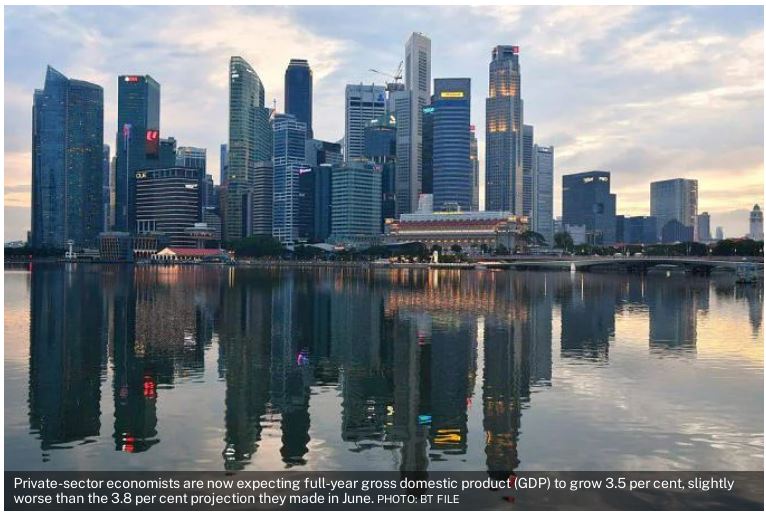Economists downgrade 2022 Singapore GDP forecast to 3.5%, raise core inflation outlook to 3.8%: survey
PRIVATE-SECTOR economists have again dialed down their expectations for the Singapore economy, according to a quarterly survey of professional forecasters by the Republic’s central bank on Thursday (Sep 1).
They are now expecting full-year gross domestic product (GDP) to grow 3.5 per cent, slightly worse than the 3.8 per cent projection they made in June.
The latest survey is based on the views of 21 respondents polled by the Monetary Authority of Singapore (MAS).
Respondents also raised their inflation forecasts, with full-year headline inflation now expected to hit 5.7 per cent, and core inflation, 3.8 per cent.
In the June survey, they had expected headline inflation at 5 per cent and core inflation at 3.4 per cent in 2022.
Specifically, headline inflation in the third quarter is expected to come in at 6.6 per cent and core inflation at 4.6 per cent, possibly indicating a cooldown from July’s record-setting figures.
But economists queried by The Business Times (BT) said respondents may also have underestimated the pace of inflation, since July’s consumer price index (CPI) was released days after the deadline of MAS’s survey, which was sent out on Aug 11.
“In its July CPI report, MAS removed its previous expectation for core inflation to peak in Q3 even as it maintained the projection for core inflation to ‘ease towards the end of 2022’,” UOB senior economist Alvin Liew told BT.
“This likely means that core inflation may stay elevated for longer. Its warnings on inflation developments remained on the upside, both on the external and domestic fronts,” he added.
But inflation should ease further in 2023, according to the respondents who have pencilled a headline inflation figure of 3.5 per cent and a rate of 3.1 per cent for core inflation.
Economists also expect the labour market to tighten further by the year-end, with overall unemployment rate down to 2 per cent instead of 2.1 per cent.
Compared with the previous survey, economists have turned more bearish on their outlook for sectors such as finance and insurance, construction, and wholesale trade.
They are however expecting the accommodation and food services sector to jump 13.8 per cent year on year, compared with an earlier prediction of 7.1 per cent year on year.
The outlook for manufacturing has also improved to 5.5 per cent year on year, compared with 4.6 per cent in the previous survey.
Notably, economists’ views on the biggest risks to Singapore’s economy have shifted in the last 3 months.
The external growth slowdown is now the most-cited downside risk to Singapore’s growth outlook and was identified by more than 7 in 10 respondents. It was also ranked the top downside risk by 57.1 per cent of respondents. In June, only 17.6 per cent of respondents considered this the top risk.
“The sudden and sharp drop in Singapore’s semiconductor manufacturing in July is a warning sign that US and global growth is deteriorating rapidly,” said Maybank senior economist Chua Hak Bin.
“Inflation may not come off as quickly in this growth slowdown because of supply chain disruptions, the green transition and climate change.”
He added that the institutionalisation of minimum wages with the local qualifying salary scheme and annual wage adjustments via the expansion of the progressive wage model will increase wage cost-push inflation to persist well into next year.
Accordingly, half the respondents identified higher-than-expected Inflation as a downside risk, with over 2 in 10 citing it as a top risk. This is however lower than in the June survey, where 88.2 per cent of respondents identified inflation as a risk and over 4 in 10 calling it a top risk.
On the other hand, lower-than-expected inflation was identified by 30.8 per cent of respondents as a possible upside risk.
Moody’s Analytics economist Denise Cheok noted that supply chain stress in the region appears to be moderating, according to research by the firm.
“The decline in supply chain stress is due to a fall in reported raw material purchase prices and an easing of commodity prices. Prices for key commodities such as oil and iron ore have fallen substantially, and this will likely ease inflation pressures in the coming months,” she said.
This could nudge central banks in the region into slowing down the pace of monetary tightening, providing some breathing room to the economy, Cheok added.
Meanwhile, geopolitical tensions is now the third most-cited downside risk, and Cheok said this is likely due to tensions involving Taiwan.
“Compared to the military conflict between Russia and Ukraine, a slowdown of the Taiwanese economy will have a more direct impact on Singapore’s trade links,” said Cheok. “Taiwan is a major producer of semiconductors, and a key export market for Singapore’s electronic products.”
More robust growth in China is the most frequently cited upside risk to Singapore’s growth outlook and was identified by 61.5 per cent of respondents. In the previous survey, almost on par with the previous survey.
But the top upside risk still stems from an accelerated revival in travel and tourism driven by the reopening of borders, according to respondents, similar to what they said in the June survey.
Source: https://www.businesstimes.com.sg/government-economy/economists-downgrade-2022-singapore-gdp-forecast-to-35-raise-core-inflation


 English
English




